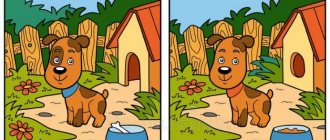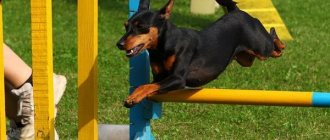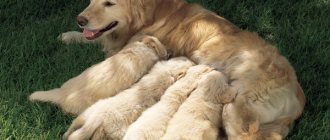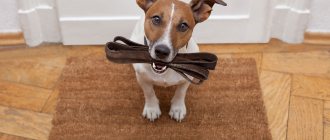You have become the proud owner of a charming little puppy. It's like a stuffed toy and fits in the palm of your hand. You want to pamper him and indulge all his desires. But you must remember that any dog, even if it belongs to a “decorative” breed, requires training.
The scientific definition of this process is: “Training is teaching a dog certain skills based on an external stimulus.”
The result of training a puppy is that it performs specific actions on your command. The purpose of training is the socialization of the animal, its desired behavior with people and its relatives, building relationships between the owner and the dog, where the “leader of the pack” is a person.
When to start training
Before adopting a puppy, it is advisable to familiarize yourself with the characteristics of the breed. This information will give you an understanding of what your pet is inclined to do and whether your personalities will get along. But each dog is an individual and has its own preferences and habits.
By working with your puppy, you can develop “positive” behavior, eliminate “negative” behavior, and begin to trust each other.
At what age should you train a puppy? This question worries people who have purchased their first dog in their life. Answer: “As soon as the puppy was brought into the house.”
To the question “from how many months can a puppy be trained?”, we can answer that training can begin as early as a month and a half, but it is better to practice OKD from three months of age.
How dogs react
Training methods
There are two of them: reward and punishment.
Promotion
How to give treats to a dog
The main method of training. It allows you to interest your baby and turn classes into a pleasant pastime. Promotes the emergence of trust and understanding between the owner and the pet.
Any correct actions of the dog and its execution of commands should be encouraged.
Incentives may include:
- Delicacy.
- Stroking, patting.
- Praise, approval.
- A game.
Punishment
Used in the educational process (during training - limited). You must immediately decide for yourself what will be allowed for your pet and what will be prohibited. Has the puppy done something wrong? Take it by the scruff of the neck and shake it. Address him in a stern voice and scold him. Place it on the floor.
If the puppy has taken a pose of submission, everything is in order, the lesson has been learned. If he tries to growl or show his teeth, the punishment should be repeated. You need to punish immediately after the “Skoda”. Then the puppy will understand what exactly caused the owner’s dissatisfaction. If you punish half an hour or an hour after the offense, the puppy will not be able to “connect” these events, will be afraid of the owner, and will grow up nervous and aggressive.
Doesn't your puppy pee outside? We will teach you how to train a puppy to go to the toilet outside.
All about the Shih Tzu breed - learn more about these cute little ones!
Here's the link: video about grooming a Chinese downy dog.
How to train a puppy at home?
Dog Training Basics
- Basic rules of training: engage with your pet only in a good mood;
- A lesson for children should last 5-10 minutes (in the future, the lesson time will increase);
- Find out what your dog's treats are. The treat should be “one bite” so that the puppy
- He didn’t chew or pick up crumbs from the floor for a long time;
- Exercise your puppy before feeding;
- Commands should be short and specific;
- Give commands in a cheerful, cheerful voice;
- Exercise several times during the day;
- When things don't work out, stop the lesson. Do not allow anger and irritation to arise;
- Try to make each lesson effective;
- Start practicing a new command only when the previous one has been mastered.
Behavior and training of Labradors
The Labrador is a companion dog and is perfect for families with children. In order for you to have a wonderful friend, you need to have basic knowledge of how to train a Labrador. The puppy can be taught all the necessary commands at home. Dogs of this breed completely trust a person, they do not expect any nasty things from the trainer, so they can exercise for a long time and with great pleasure. They love human interaction, so they will happily accept a stroke or a kind word as praise instead of a treat. The Labrador is a very peaceful dog; he will be less distracted during training with other animals, unlike fighting breeds. These dogs have an excellent temperament - they cannot be called lethargic, but they are not impulsive, moderately active, with healthy motor activity - just what is necessary for successful training.
Practicing commands
1. The puppy must learn its name.
Communicate with the puppy like a child, commenting on your actions and calling the puppy by name. Put a bowl of food, call: “Charlie, eat.” They picked up the leash: “Charlie, go for a walk.” Briefly, without further ado. Dogs very quickly remember their “favorite” words (walk, sausage, eat, play) and their nickname. It is learned if the puppy turns its head to its name, pronounced by you in a calm voice, or runs when you call.
2. Accustoming to a harness and leash.
Leash training
For dogs of decorative breeds, a harness is used rather than a collar. Be prepared for the fact that a fearful reaction may follow when wearing a harness for the first time. It is best to distract your baby with a game. Let him play in the harness for a while, then remove the harness and give your pet a treat. When the puppy understands that you are putting a harness on him before a walk, he will bring it himself and ask to be walked with him. Nobody pays attention to the leash: there are so many interesting things on the street, what kind of leash is there. Simply attach it to the harness and take your dog out.
3. Basic prohibition.
Team "Ugh!"
Your pet faces many dangers in the human world, so one of the first skills you should teach your puppy is the “Fu” command.
He is prohibited:
- Picking up food from the ground.
- Rush at other dogs.
- Shit in the house.
- Biting (even in play).
- Chew the owners' things.
- You can add to the list.
To stop unwanted actions, the command “Fu” is given. It should be pronounced in a stern voice. If it happens on the street, the order is accompanied by a jerk of the leash. At home, you can flick your puppy on the nose or slap him on the butt with a newspaper. After completing the command, you can call your pet to you and praise it.
The commands “No”, “Spit”, “Drop” are non-standard, and are a variation of the “Fu” command. If it is more convenient for you to use one of them, please do so. The main thing is that the puppy completes them quickly and without hesitation. Often, this can save his life.
4. Command “Come to me”.
Team "Come to me"
Its training begins only after the puppy has learned its name.
Sequencing:
- Say the puppy's name. He must react to it (look at you).
- Show him the treat and quickly move away from the puppy so that he sees your hand with the treat, saying “Come to me.”
- After the dog runs up to you, give it a treat, pet it, and praise it.
When the puppy learns to carry out this command well indoors, you can move on to training outdoors. There are many more distractions here. The order “come to me” is carried out using a leash, which must be twitched until the dog turns and starts moving in your direction. She came up, praised her, and gave her a treat.
Some owners, when their pet has misbehaved, call it, saying “Come to me” and punish it. This is strictly prohibited, otherwise the dog will stop listening to you altogether.
5. Teaching the command “Sit!”
Teaching the command “Sit!” by pressing on the animal's rump
The command “Sit!”
Call the dog with the order “Come to me.” When she approaches, press your palm on her croup, forcing her to sit down. At the same time, make a gesture with your other hand that will indicate the command “Sit” (showing the dog a vertical palm). Remove your hands, saying: “Sit, sit.” Give your puppy a treat if he does everything correctly. If you remove your hands and the dog stands up, say the marker “no” and repeat all over again.
6. Practicing the “Stand” command.
Command "Stand"
Teaching the “Stand” command by pressing on the animal’s croup
The first stage of practicing the command is to force the puppy into a “standing” position.
- Put a leash on your dog.
- Say: “Sit.”
- By pulling the leash forward and up, force the puppy into a standing position. Make an open palm gesture from bottom to top and say the command “Stand.” Reward your dog for doing the right thing.
Second stage : teach your pet to stop if there is some kind of threat (crossing the road, fighting with another dog, etc.)
We practice it outside with a leash. We command “stand” and move away from the dog. If she stays in place, we give her a treat and praise her. If he starts moving after you, we say “no” to the marker, pull the leash and return to the starting position.
Interested in a detailed description of the breed?
If you are interested in a detailed description of the Pomeranian Dwarf Spitz breed, go here!
Professional advice from breeders on how to choose a French Bulldog puppy.
7. Team "Place".
Take the puppy to his bedding, lay him down, saying “Place”, and treat him to a treat. A few weeks later, when you come home after a walk, command “Place.” If the dog goes to his bedding, praise him and give him a treat.
8. Fetch!
- Teach your dog to simply take an object in its mouth and give it back with the command “Give.” If your dog drops an object, say “no” to the marker and do not give the treat.
- Place the item on the floor and say “Apport.” The dog must pick up the object and hold it in its mouth until you command “Give.”
- Give the command “Stay”, move away from the dog, put the retrieval on the floor and walk away. "Apport" command. The dog must pick up the object and bring it to you.
- Throw the object, holding the dog by the collar, give the command “Apport!” The dog brings an object.
At all stages you reward for the right actions.
Basic rules for raising a puppy
Before talking about where to start training a puppy, you should learn the following rules:
- You can start training only if the dog is healthy, cheerful and cheerful. You should not try to teach commands to a sick or tired four-legged friend.
- After the puppy gets into the house, you need to give him time to adapt to the new environment, get used to the new food, and fall in love with his owner. Experts say that five days is enough for a puppy to adapt.
- Before you start training your puppy, he needs to be accustomed to a collar and leash.
- The lesson should be carried out in a playful way, as with a child, its duration at a time should not exceed 40-60 minutes, otherwise the baby will get tired and stop listening, become lethargic or capricious.
- The main motive for a puppy is praise and treats, so it is advisable not to feed him too much before training.
- Choose only one command for a particular action and do not change it. If the puppy has learned the command “Come!”, he will not understand your call “Come here!”.
Another important point is that the result of training depends on the breed of the dog. For example, training a shepherd dog, St. Bernard, Rottweiler, boxer, dachshund, or poodle puppy will be successful. Training small breeds is always more difficult, because the nervous system of small dogs is weaker, they are more susceptible to stress, and get tired faster.
Game in a dog's life
Small dogs love to play from early childhood until old age. A toy (and owners buy countless toys for their pets) is very important for the normal development of your pet. He also needs your games together. This is a great way to begin to understand your dog's language and build a friendly relationship with him.
Playing with your pet outside will save him from many troubles. A dog that has been running around during a walk and has had enough of playing with its owner will never “misbehave” at home; it simply does not have the strength or energy for this.
Many of the commands mentioned above can be practiced while playing with your favorite.
Playing is a good way to relax your dog after a stressful training session. The puppy will be more willing to exercise if he knows that a reward awaits him at the end - a game with his adoring owner.
Video about training a puppy and overcoming the crisis of independence:
Dog breeds that are easy to train
Before purchasing a puppy of a certain breed, it is recommended that beginners find out how well it will respond to training. Dogs, like people, have their own personalities. Some are naturally obedient, others are stubborn or like to play tricks.
It is believed that the following breeds are best suited for training:
- German bearish. Despite the fact that these are large dogs, even a child can handle them. But only on the condition that they start training from puppyhood. If they do not immediately receive the right upbringing, they become uncontrollable in adulthood;
- Italian Canne Corso. There will be no problems with this dog either. She has an excellent memory and likes to obey her owner. The only drawback of this breed is that they do not get along well with other dogs;
- The Basset Hound is a good-natured hunting dog that quickly gets along with children. Easily trainable at an early age;
- Black Russian Terrier – recognizes people only with an iron will. But if he meets such a master, he obeys him in everything;
- Maltese - this small dog, although capricious, is easy to train;
- The German Shepherd is one of the most loyal dogs. Her character is self-possessed. She can be an excellent nanny for a child. She likes to obey her master. German Shepherds also truly love and know how to work.










